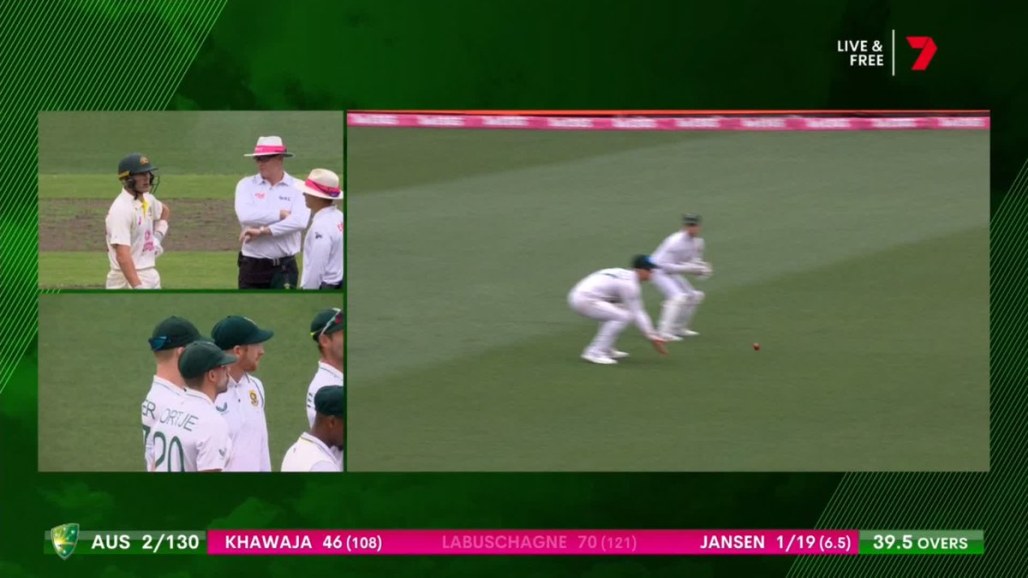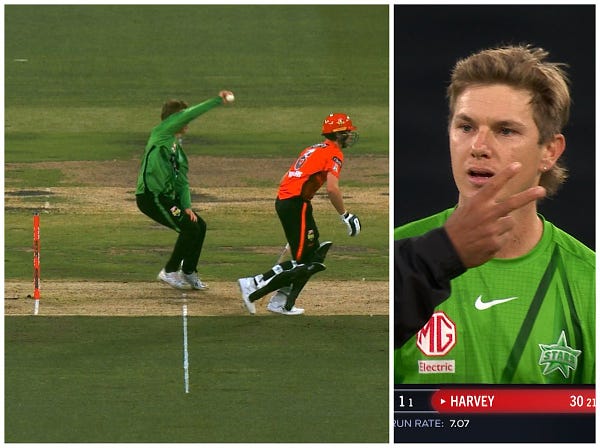This question is asked millions of times in every match. It is worded in various ways. Most commonly, it is asked using the words “the law is too vague, it requires a subjective judgment”. Less commonly, it appears in things like advocacy for the soft-signal on low catches to be discarded. In such less common cases, this question has a detrimental effect on the game because rule changes put in place to appease the mob make adjudication more difficult (as was evident in the catch claimed at 1st slip at the SCG today). In 2021, the Umpire’s Call zone was modified to similarly appease the mob. This made reviews of LBW appeals objectively worse.
Umpires do not have “subjective” opinions on the field. Aleem Dar and Paul Reiffel do not give decisions based on their personal tastes or feelings. They give them based on their professional training, and the disciplined methods which written in the laws.
Consider the case of Mankading. The law was correctly enforced in the BBL this week when an appeal for a run out of the non-striker by Adam Zampa was disallowed because he was adjudged to have passed “the instant when the bowler would normally have been expected to release the ball” before effecting the run out. The MCC issued helpful clarification providing the rule of thumb the umpires use to evaluate whether the bowler has passed this instant.
A whole bunch of people who treat individual clauses in the law like a menu from which they can pick out stray phrases with which to beat up on umpires were outraged by this. “Is it vertical, or is it the instant when the bowler would normally have been expected to release the ball?” they asked. Because those are not the same thing according to them.
It’s worth reflecting on an interesting point here about the nature of evidence. The law is written to be enforced by the umpire on the field - to evaluate live action. It specifies a time frame - “from the moment the ball comes into play” until “the instant when the bowler would normally have been expected to release the ball”. Law 38.3 specifies that the non-striker can be run out at the non-striker’s end (“the non-striker is liable to be Run out”) before the ball is delivered if the run out is effected within the time frame specified in the law.
The factual evidence in the live action is shaped by the umpire’s view of how far the bowler’s action has progressed. The guidance to the umpires says that if the arm has gone past the vertical, then the bowler has gone too far.
The factual evidence in the TV review is shaped by the available frames of video. This is deceptive because the question of law is not whether the bowler is past the vertical, the question of law is still whether the bowler has gone past the instant when he would be normally expected to have released the ball. The TV Umpire knows this.
The point of spelling out all this, is that the umpires explicitly do not give decisions based on their feelings. They give decisions based on the factual evidence and on specifications of the law. Under the subjective/objective distinction above, the umpires give decisions objectively.
The subjective/objective distinction is not useful when understanding umpires or referees. All umpires and referees are, by definition, objective. What makes them umpires is that they rule on the basis of the Laws of Cricket and the factual evidence. What the subjective/objective distinction fails to account for, is that ruling on the basis of the law and the facts of each appeal, involves exercising judgment, because perfect information is rare (when information is ‘perfect’, typically no decision is required from the umpire).
The Laws also provide guidance on circumstances when there is factual uncertainty. This is typically done procedurally (such as with the soft-signal, which signifies which way the decision should go if the facts of the particular low catch are uncertain in the TV replays. Another example of this would be Umpires Call. A more generic example would be the proposition which is colloquiually described as “giving the benefit of doubt to the batter”. This is not a favor to the batter. Rather, it is that the umpire should give a decision only when the facts point to it. When the facts are uncertain, the status quo should prevail. This typically means letting the batter stay in.
Why does the umpire get to decide? Because a disciplined answer is required. Umpires and referees give that disciplined answer based on the laws and the facts available for each appeal.
An ambiguous Law is a contradiction in terms. There are no Laws in cricket which are ambiguous. Any fair consideration of the Laws makes this clear. Fair consideration does not treat individual laws as a menu from which phrases can be picked apart. It treats individual Laws as a constitutive part of a whole structure which is cricket.
There are Laws which are not enforced. But this enforcement, in cricket, is the duty of the competing teams. For example, in the T20 International between IND and SL, more than once, the batter picked up the ball up and returned it to the bowler after playing it down at his feet. In all such cases, had the bowling side appealed, the batter would have been Out Obstructing The Field (Law 37.4). But bowling sides typically do not enforce this, they consent to the batter picking the ball up and returning it to them (however implicitly this consent is communicated). It is not upto the Umpire to enforce this Law.
The umpire gets to decide because the umpire is trained to decide based on the law and the facts. The umpire is a specialist expert. However tempting it may be to ask “What would I do if I was the umpire?”, asking that is as absurd as asking “What would I do if I was facing up to Kagiso Rabada bowling at 90 mph?”
Compared to the umpires or the players, you and I are raw material for the mob. The question is are we prepared to join the mob for our entertainment? Or are we prepared to be fair to the game for our entertainment?







Agree with the overall sentiment of the piece, but a couple of things.
[Umpires] do not give decisions based on their personal tastes or feelings > Occasionally, they do. There's some evidence in peer-reviewed research: https://eprints.whiterose.ac.uk/86816/3/WRRO_86816.pdf This doesn't make them bad professionals. Biases are part of being human, even though DRS has clearly reduced the chances of biased decision-making. However, even now, you can often see the wheels turning in an umpire's head when they make a decision. E.g., consider a marginal-looking LBW call in the last session of a test match. Let's say the batting team has one wicket remaining and no reviews left, whereas the bowling team has two reviews in the bank. How likely is the umpire to give it out? I'd say the umpire would be clever to forget about their training in that instant and make the decision based on factors unrelated to the only things that should matter in the classical view of umpiring - {impact, pitching, hitting}.
An ambiguous Law is a contradiction in terms > Laws (or at least how they apply to specific situations) are ambiguous all the time. If this weren't true, the world wouldn't need lawyers - judges would be enough for the most part. Ambiguous laws are the reason why amendments are made and why a "helpful clarification" is sometimes required. But... rather than getting into semantics, a better question to ask is - do the laws of cricket cover *everything* that can happen on a cricket field? Clearly, work is still being done in this area. I find it reductive to suggest that the questioning of umpiring decisions is entirely due to the anger of a mob.